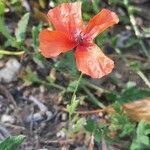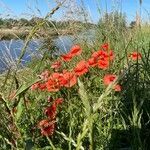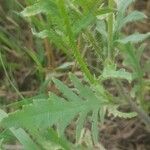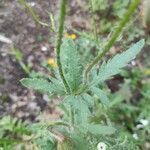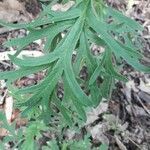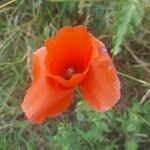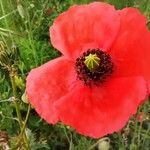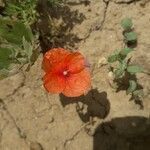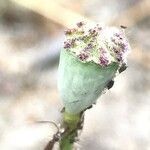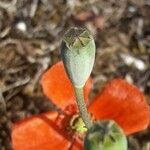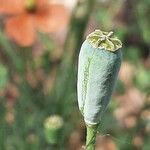Annual herb; rosette usually present; stems erect, finely hispid, 20-30-(80) cm tall. Lvs ± glaucous, petiolate especially the lower, 5-10-(15) × 2-7-(10) cm. Lamina oblanceolate or lanceolate to ovate, abruptly narrowed at base, deeply 1-2-pinnatisect, hispid. Pedicels 10-30-(45) cm long, hispid; hairs spreading in lower ⅓, appressed above. Sepals hispid, (5)-15-20 × (3)-10-15 mm. Petals red, 1-3 × 1-3 cm, with basal blotch faint or 0. Capsule clavate to oblong-obovoid, widest above 1/2 way, slightly ribbed, glabrous, (7)-15-25 × (3)-5-10 mm. Stigmatic disc = width of capsule, conic at first, flat when ripe; rays (4)-5-8-(10).
Sparingly branched, ± hispid annual 3–6 dm; lvs pinnately divided, the pinnae toothed to deeply incised; peduncles appressed-hairy above; buds under 2 cm; pet 1.5– (–3.5) cm, red to pink or red-orange, often with a basal dark spot; anthers purple; fr glabrous, 1.5–2.2 cm, obconic or narrowly obovoid, not strongly ribbed; stigmatic rays 5–9; 2n=42. Native of Europe, sparingly intr. or escaped in waste places in our range. May–Aug.
An annual herb. It grows 30-60 cm tall. It can have a few branches from low down. The latex is milky. The leaves are divided into deep lobes. They are 7-15 cm long by 2-3 cm wide. The flower buds are oval. The flowers are 2-3 cm across. They are at the end of the branches. They are pink or red with a dark blotch. The fruit is an oblong capsule. It is 15-20 mm long. The seeds are very small.
Plants to 7 dm, hirsute to hispid. Stems simple or branching. Leaves to 20 cm. Inflorescences: peduncle proximally spreading-hispid, distally appressed-hispid. Flowers: petals orange to red, rarely with dark basal spot, to 3 cm; anthers violet; stigmas 7-9, disc ± flat. Capsules sessile or substipitate, narrowly obovoid, usually distinctly ribbed, to 2 cm, 2 times or more longer than broad.

